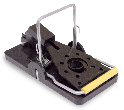Bats are important in any eco system. A single bat can eat up to 1,200 mosquito sized insects in one just one hour. Bats usually have one litter a year consisting of 1-2 babies. Bats can squeeze into very tight spaces and only need 1/4" of space to gain entry into your home. They are nocturnal animals, so it is easy to see them leave and return to your home.
Bat droppings, or guano, are a breeding ground for a fungal disease called Histoplasmosis that can be transferred to humans simply by breathing in the fungal spores. Histoplasmosis is characterized by fever, anemia, and emaciation. Once the bats have been removed, it is recommended to have a professional team come out to remove the excrement.
Bats are also known carriers of rabies, so the sooner you detect them residing in your roof or attic, the better off you will be in having them removed. Keep in mind, in the US, it is not recommended to remove bats when they have young who can't fly.
If you have a bat that has flown in your home, it could simply be a youth that lost its way and its only goal is to get out safely. Most bats will leave on their own if there is an open window or door. Bats are not usually aggressive; however, they may bite if handled. If the bat doesn't leave of its own accord, get a small shoe box and a flat piece of cardboard. Cover the bat with the box; slide the cardboard between the box and wall. Once the bat is inside the box take it to the nearest exit and allow the bat to fly free. Use gloves so there is no direct contact. Should the bat bit you, seek medical attention immediately.
It is important to keep all areas sealed to prevent bats from coming into attics or garages to roost. However, if they get in and take up residence, install one way valves to allow them out, but not to regain access. Valves can be constructed from plastic pipes and plastic netting. Netting should be 1/6" or smaller to prevent access. These devices need to be kept in place for up to 10 days to insure all bats have exited the residence. Keep in mind all bats do not come and go at the same time.
Once it has been established that all bats have be removed, take down the one way valves and caulk the area to prevent future roosting. Apply the caulking so it has time to dry in the heat of the day.

The End of the Road for Mice! Quickly eliminate pesky mice and small rodents with this handy six-pack of traps. Easy to bait, set, use, and release. Unique design catches rodents from the front, sides, and back. Simple, safe, sanitary, and reusable for years. Check out Snap-E Mouse Traps today!
Don't make it easy for raccoons to enjoy feasting on your garbage. Remove their water source and double-bag pungent ...
Discover MoreThere are a few simple measures that you can take to deal with nuisance dogs, instead of shooting at them. If the dog ...
Discover MoreBirds can be beautiful to watch, and sometimes we encourage them to be part of our environment. However, sometimes birds ...
Discover MoreThere are currently no comments for this tip. (Be the first to leave your comment—just use the simple form above!)
Copyright © 2026 Sharon Parq Associates, Inc.
Comments